Six workers presumed dead after Baltimore Key Bridge collapse. Here’s everything we know
President Joe Biden announced he would be visiting Baltimore next week and his administration approved $60m in emergency aid after the Dali container ship collided with the city’s Francis Scott Key Bridge, causing it to dramatically collapse and throwing members of a construction crew into the cold water below.
The exact cause of the 26 March collision is still unknown. As the investigation is still underway, the mission has shifted from one of recovery to one of clearing the waters.
“This work will not take hours. This work will not take days. This work will not just take weeks. We have a very long road ahead of us. We understand that. And we’re prepared,” said Maryland Gov Wes Moore. He praised the Biden-Harris administration’s release of funds, as the Biden administration has promised to use federal funds to rebuild the bridge.
While the state works to quickly restore the Baltimore port, the community mourns six members of a construction crew, who were refilling potholes and fell into the Patapsco River when the Dali slammed into the bridge.
After a 17-hour search for the missing men on the day of the incident, the Coast Guard suspended search operations, presuming that the six unaccounted-for workers were dead at that point.
The search team found two bodies in a submerged red pickup truck the following morning. Four remaining workers are presumed dead and rescuers have been unable to retrieve their bodies from the wreckage of the bridge.
So far, four of the six missing men have been publicly identified.
Here’s what we know about the Baltimore bridge collapse:
The collision
At around 1.30am ET local time, the Singapore-flagged vessel Dali struck a column on the Francis Scott Key Bridge, leading multiple parts of the 1.6-mile-long bridge to tumble into the water.
Just moments before the collision, the ship’s crew issued a mayday call. Maryland Gov Wes Moore added that the call “undoubtedly saved lives,” giving time for authorities to stop cars from continuing on the bridge.
The crew warned the Maryland Department of Transportation that a collision with the bridge “was possible,” the report said. “The vessel struck the bridge causing a complete collapse.”
It’s still unclear what caused the accident. But the ship was just 30 minutes into its 27-day journey to Sri Lanka.
Marcel Muise, the chief investigator for the National Transportation Safety Board (NTSB), said data from the shipping container’s voyage data recorder, sometimes referred to as a “black box”, was still being analysed.
Mr Muise said that around 1.27am on Tuesday, one of the two pilots of the Dali had made radio contact regarding a “blackout” and ordered for the port anchor to be dropped as well as issuing additional steering commands.
Several seconds later the pilot issued another radio call over the radio reporting that the Dali had “lost all power and was approaching the bridge,” Mr Muise said.
Transportation authorities say the water under the bridge is around 50 feet deep.
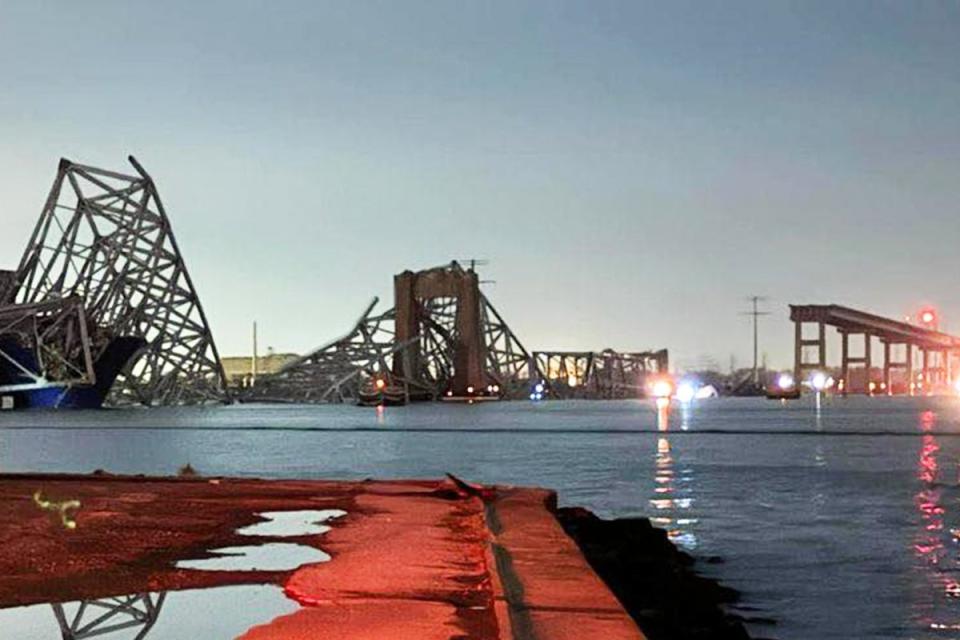
There was no indication that the crash was intentional, officials said.
Kevin Cartwright, director of communications for the Baltimore Fire Department, told The Associated Press that it appeared there were “some cargo or retainers hanging from the bridge”, creating unsafe and unstable conditions, and that emergency responders had to operate cautiously.
Jennifer Homendy, chair of the NTSB, said that over 750 tonnes of hazardous materials had been onboard the Dali container ship when the crash occurred.
An NTSB hazmat investigator was able to identify 56 containers of hazardous materials, a total of 764 tonnes of hazardous materials, Ms Homendy told a press conference on 27 March. The materials were “mostly corrosives, flammables, and some miscellaneous hazardous materials”, she added.
Some of the hazmat containers were breached, though state authorities have been made aware.
The missing men
Eight people were initially believed to be in the water after the container ship collided with the bridge — four of whom are still missing.
Two survivors were pulled from the water on the day of the collision. One has been taken to a trauma unit and is in serious condition, while the other was uninjured.
Mr Cartwright said the city was dealing with a “developing mass casualty incident”.
A multi-agency rescue ensued, in search of the six missing people, with dive team members going into the river to try and locate them.
The Coast Guard also deployed small boats and helicopters to help in the search.
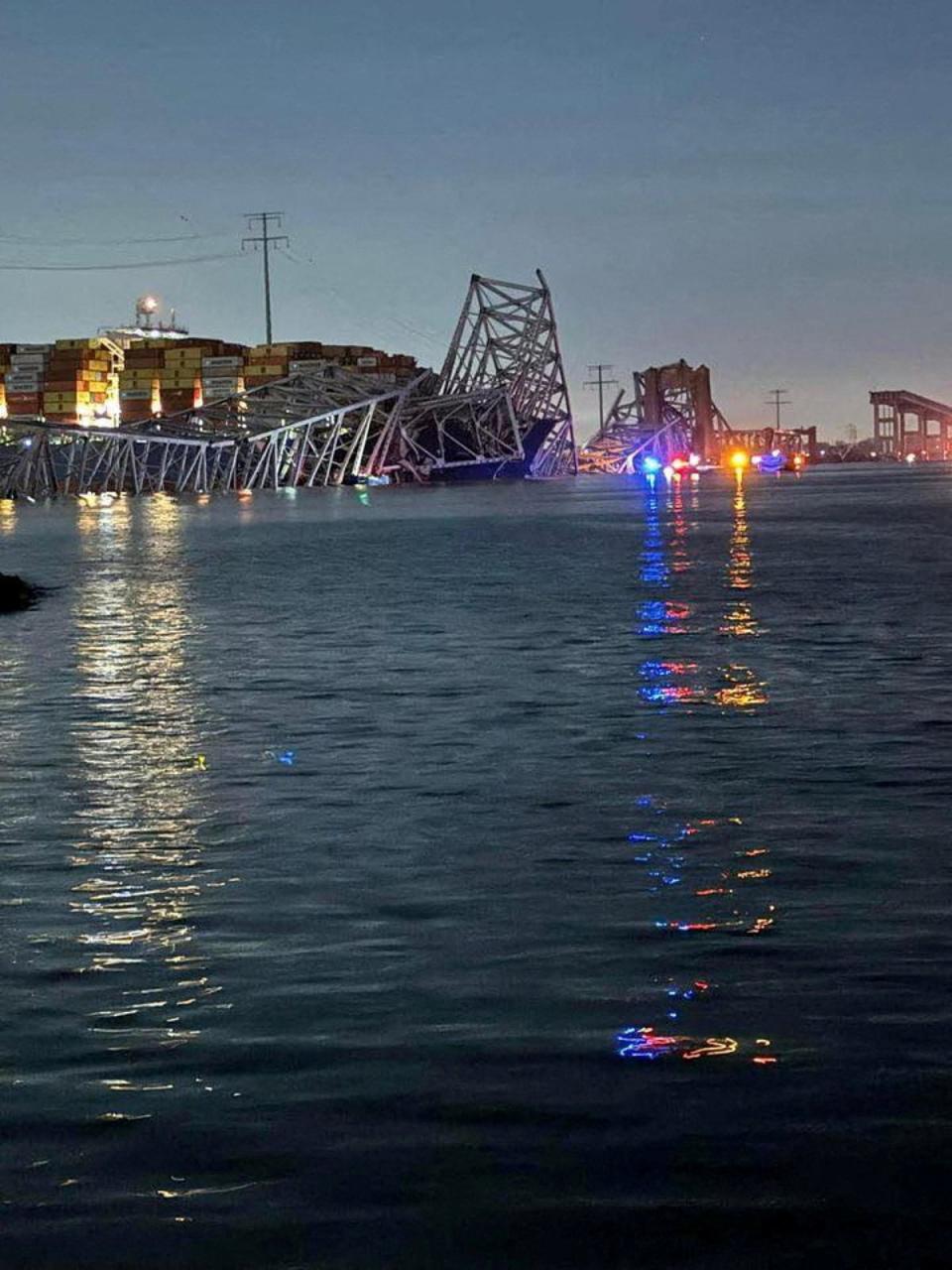
After almost a full day of searching for the six, the Coast Guard announced at 7.30pm on Tuesday evening that the search was suspended and would transform into a recovery effort the next morning.
“I’d like to announce tonight that based on the length of time that we’ve gone in this search, the extensive search efforts we’ve put into it, the water temperature, that at this point we do not believe that we’re going to find any of these individuals still alive,” said Rear Admiral Shannon Gilreath.
Officials revealed that the missing six were members of a construction crew — employed by Brawner Builders — hired to refill potholes.
Brawner Builders employee Jesus Campos told The Baltimore Banner that the still unaccounted-for individuals are all men in their 30s and 40s.
“They are all hard-working, humble men,” Mr Campos told the outlet.
Two of the men — Miguel Luna and Maynor Yassir Suazo Sandoval — were named by family members as being among the workers on the bridge who went missing after the structure collapsed into the river below.
Both men were married and had children. Luna was from El Salvador and Sandoval was from Honduras; they had both been living in the US for nearly two decades.
Their bodies have not yet been recovered.
Col Roland Butler Jr of Maryland State Police said at a 27 March evening press conference that agencies made a “tragic finding” just before 10am that morning: a red pickup truck submerged in 20 feet of water with two victims trapped inside.
They were identified as Alejandro Hernandez Fuentes, 35, and Dorlian Ronial Castillo Cabrera, 26. Fuentes was from Mexico while Cabrera was from Guatemala.
‘An unthinkable tragedy’
The Francis Scott Key Bridge collapse is an “unthinkable tragedy,” Baltimore city mayor Brandon Scott said.
“We have to be thinking about the families and people impacted, folks who we have to try to find. This is what our focus should be on right now, we’re going to continue to work in partnership with every part of government to do everything we can to get us through the other side of this tragedy,” he said.

Maryland Gov Wes Moore declared a state of emergency in his state hours after the bridge’s collapse.
On 27 March, the governor announced that the flags would be flown at half-staff. Later that day at a press conference, he said, “The collapse of the Key bridge is not just a Maryland crisis. The collapse of the Key Bridge is a global crisis. The national economy and the global economy depends on the Port of Baltimore.”
In the immediate aftermath of the tragedy, the White House called it a “horrific incident.”
Press Secretary Karine Jean-Pierre gave condolences on behalf of the White House at a press conference: “Our hearts go out to the families of the six individuals still missing.”
Mr Biden told reporters on Friday, 29 March that he plans to visit Baltimore next week.
How did the crash occur?
The cause of the collision is still being investigated, but evidence suggests the vessel lost power just before it crashed into the bridge.
The NTSB recovered the voyage data recorder (VDR), or “black box,” which provided a minute-by-minute timeline of the lead-up to the crash.
The data was made public on 27 March, showing that the Dali departed from Baltimore’s Seagirt Marine Terminal at 12.39am on Tuesday 26 March.
By 1.24am, the ship’s bridge audio recorded numerous alarms. Around the same time, the VDR stopped recording the vessel’s system data, but it was able to continue taping audio from an alternative power source.
The VDR resumed recording the system data and captured steering commands and orders about its rudder. Seconds later, the ship’s pilot issued a radio call to tugboats close by asking for assistance for the stricken vessel. The pilot association dispatcher then called the MDTA duty officer about a blackout, NTSB said.
A minute later, the pilot ordered the Dali to drop the port anchor and issued another high-frequency radio call, reporting that the ship had lost all power and was approaching the Francis Scott Key Bridge.
A transit authority duty officer alerted two units — one on each side of the bridge — who were already on the scene and ordered them to stop traffic, shutting down all lanes.
Two minutes after the warning call was made, at 1.29am, the VDR recorded 33 seconds of sound “consistent with” the vessel colliding into the bridge, the NTSB wrote. The Dali was moving at just under 8 miles per hour.
The pilot then radioed the US Coast Guard to report the bridge had come down.
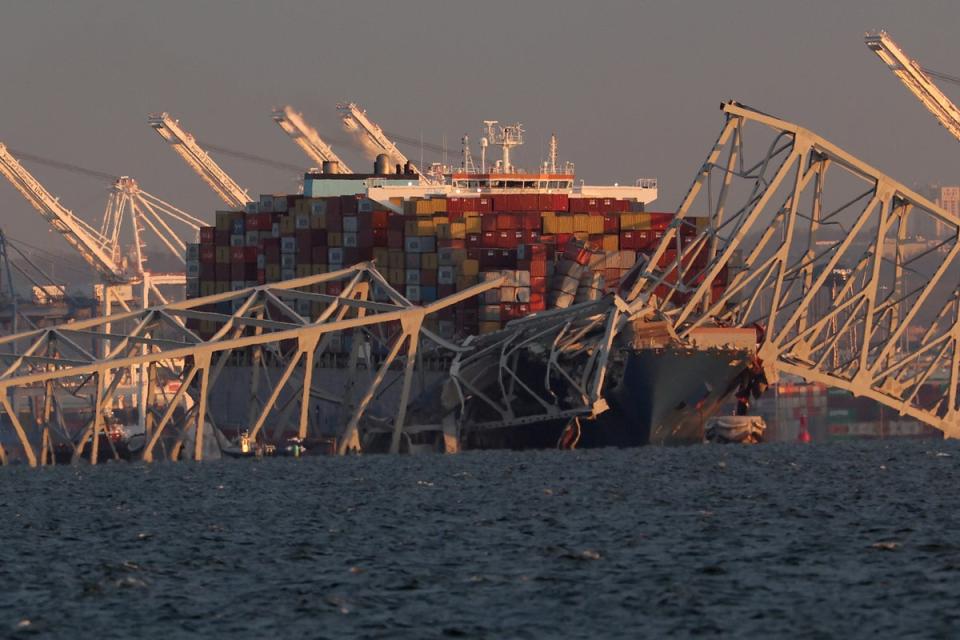
While deeper analysis of the black box data has yet to come out, some experts have also questioned whether the structural integrity of the bridge itself was strong enough.
Julian Carter, a structural and civil engineering expert, earlier told Sky News that the structures of the bridge were “very weak” at certain points.
Fire officials said earlier that they do not have any information as to whether there was a problem with the 300-metre-long ship, and have not spoken to the pilot of the vessel yet.
Chief Wallace added that he could not confirm if there had been a fuel leakage from the cargo ship.
“We hope as the sun comes up, we will get a much better picture if we do have a fuel spill and what the impact has been so far,” he said.
Gov Moore said on 27 March that it’s still unclear what caused the ship’s power to go out. “There needs to be accountability to make sure these things do not happen again and that we have a system in place to make sure they don’t,” he said at a press conference.
Recovery efforts
State officials announced they have suspended recovery operations, due to safety concerns for divers and an inability to reach vehicles.
Gov Moore announced on Thursday that the operation to clear debris was set to begin after the Biden-Harris administration approved the governor’s request for $60m to fund the relief effort.
The governor noted that the initial funds will “serve as a down payment toward initial costs, and additional Emergency Relief program funding will be made available as work continues.”
Although Mr Moore did not provide an exact timeline for how long the process will take, he warned, “This work will not take hours. This work will not take days. This work will not just take weeks. We have a very long road ahead of us. We understand that. And we’re prepared.”
At a Friday press conference, Gov Moore labelled the incident a “human tragedy,” adding, “We need to continue to focus on recovery because we need to give a sense of closure to these families.”
The recovery efforts were paused as the conditions were deemed unsafe for divers until the wreckage was cleared, the governor said.
On Saturday, authorities said that rescue divers remained “on standby” and would return to the waters as soon as conditions improve. Governor Moore told reporters: “Right now, the conditions make it unsafe for rescue divers. But as soon as those conditions change, Colonel [Roland] Butler has assured me that those rescue divers will be going right back in the water.”
Four massive cranes are coming in to help lift the wreckage.
Two have arrived, one arrives tonight and the fourth is arriving on Monday, Mr Moore said.
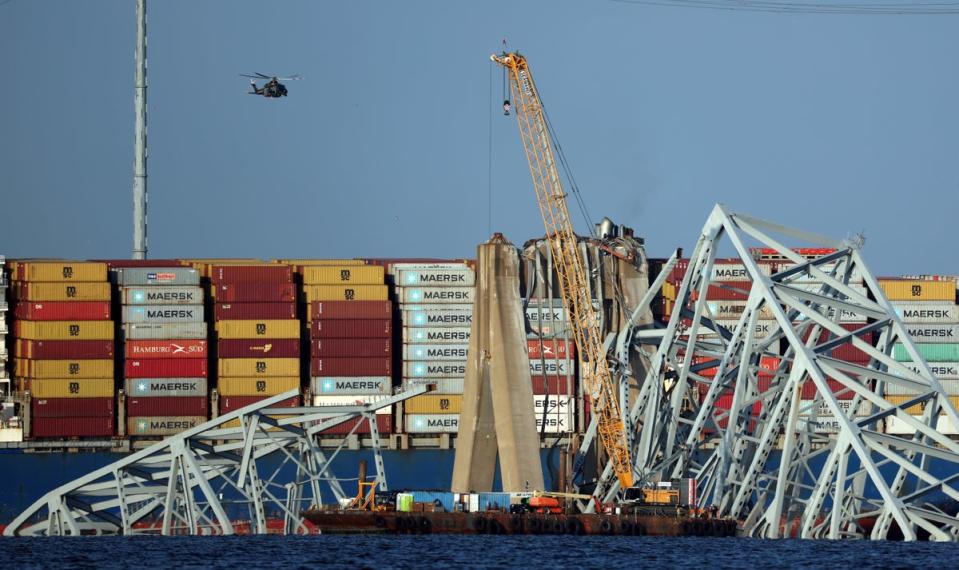
One of the cranes — the Chesapeake 1000 is capable of lifting 1000 tonnes — but the Key Bridge weighs somewhere between three and four times that, “so the bridge needs to be cut into sections,” he explained.
The first crane lift of debris was scheduled to take place on Saturday.
At a press conference, Coast Guard Rear Admiral Shannon Gilreath said: “This is a step in that process, much like when you run a marathon, you’ve got to take the first few steps. We’re taking those few first few steps, and will continue to get the resources in that will propel us to the finish line, but we’re working to get there as fast as we can.
“We’re going to open it as soon as possible and we’re gonna continue to do it safely.”
The container vessel Dali
All members of the crew were accounted for after the crash.
The Dali’s 22-member crew and its two pilots were all safe, Synergy Marine Group said in a statement. One crew member sustained “minor” injuries and has since been treated and discharged from the hospital. The injured crew member returned to the vessel on 27 March, the company said.
Interviews conducted by the NTSB with the two pilots of the Dali container ship are scheduled for Thursday, 28 March.
Jennifer Homendy, NTSB chair, said that an interview with the ship’s captain had taken place on 27 March, along with the mate, chief engineer and one of the other engineers. She added that the container ship currently has power, but is stationary.
“They are not sitting in the dark, but it cannot move,” she said.
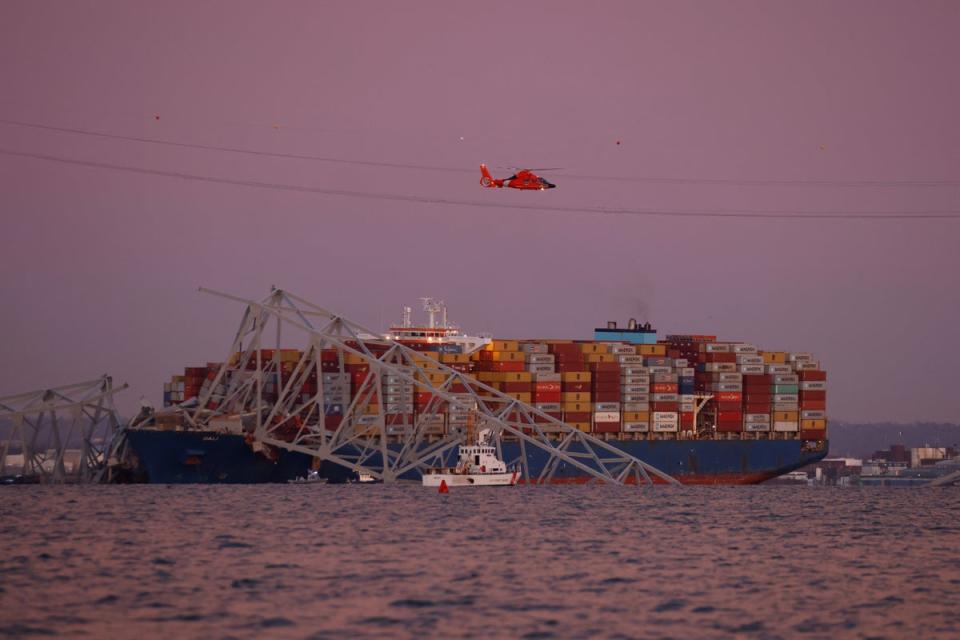
The boat’s length overall (LOA) is 299.92 metres and its width is 48.2 metres.
The Dali had just set sail and had only travelled just over four miles from the Seagirt Marine Terminal in the Port of Baltimore before it collided with the west side of the Francis Scott Key Bridge, according to VesselFinder.
It was about to embark on a 27-day journey to Colombo, Sri Lanka, which is roughly 10,220 miles, although it only managed to complete a fraction of its journey – about 30 minutes – before it crashed.
While the vessel “had a fairly good safety record,” Mr Buttigieg noted, the Dali had reportedly been involved in another “incident” back in 2016, port authorities told CNN.
The same ship that struck the Francis Scott Key Bridge was also involved in an incident at the Port of Antwerp in Belgium, the outlet reported.
According to Vessel Finder, the Dali reportedly collided with the side of the stone wall quay as it was leaving the port, and consequently damaged the stern and transom of the vessel.
The incident was reportedly blamed on a mistake by the ship’s master and pilot onboard and there were no injuries.
Separately, the Maritime and Port Authority of Singapore said that the Dali had “passed previous foreign port state inspections,” according to a 27 March statement.
While the vessel passed two separate foreign port inspections in June and September 2023, the agency noted that during June, the ship suffered from a “faulty monitor gauge for fuel pressure,” which was “rectified before the vessel departed the port.”
In June 2023, a port in Chile reported an issue with the fuel heater’s pressure gauges before it was fixed before departing, the Associated Press reported.
The Independent has asked the Maritime and Port Authority of Singapore to clarify at which foreign ports the inspections took place.
The Francis Scott Key Bridge
Before the Francis Scott Key Bridge catastrophically plummeted into the Patapsco River, the structure had stood for 47 years in its completion as the final link in the I-695 (the Baltimore Beltway).
The bridge got its name from Francis Scott Key, the man who penned the US national anthem The Star-Spangled Banner, who also happens to be a distant cousin and the namesake of the writer F Scott Fitzgerald.
The Maryland native was thought to be close to where the bridge was eventually erected when he witnessed the bombardment of Fort McHenry in 1814, inspiring him to write the words to the anthem, the Maryland Transportation Authority wrote on its website.
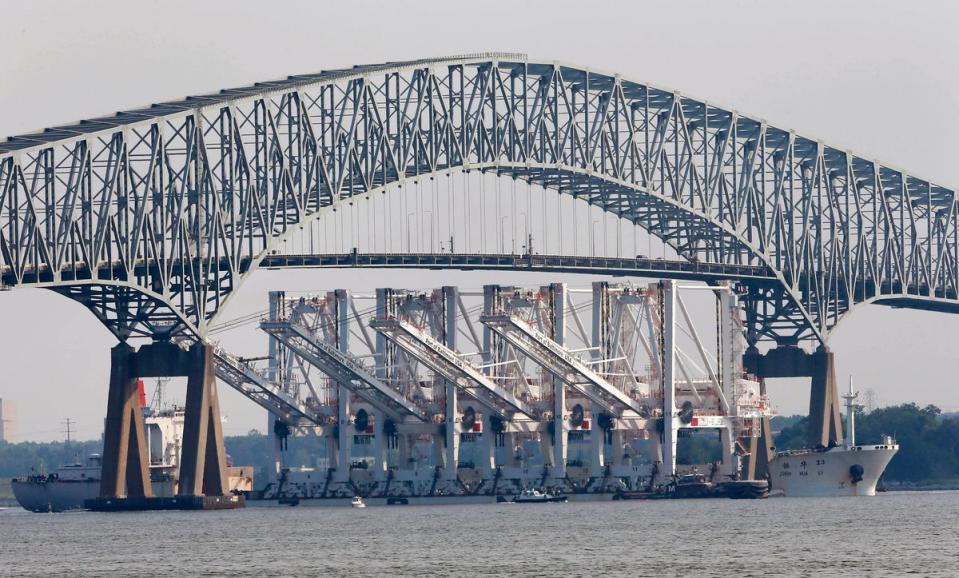
It took five years to complete the bridge, between 1972 and 1977 and carried some 11.3 million vehicles a year before it fell into the river on Tuesday.
The four-lane steel bridge spanned 1.6 miles across the river and had 185 feet of vertical clearance.
The bridge leads up to the Port of Baltimore, which is the US’s busiest port for car shipments, according to data from the Maryland Port Administration, Reuters reports, as well as being the largest US port by volume for handling heavy farm and construction machinery.
NTSB Chair Homendy said that the bridge was “fracture critical” but had been in “satisfactory condition” prior to the crash.
The last inspection of the bridge occurred in May 2023. The structure receives over 30,700 vehicles crossing it each day, Ms Homendy said.
“The bridge is fracture critical. What that means is if a member fails, that would likely cause a portion of or the entire bridge to collapse,” Ms Homendy told a press conference on 27 March.
“The preferred method for building bridges today is that there is redundancy built in whether that’s transmitting loads to another member or some sort of structural redundancy. This bridge did not have redundancy.”
There are 17,468 “fracture critical” bridges in the United States out of around 615,000 bridges total, according to the Federal Highway Administration (FHA).
“This bridge was in satisfactory condition,” Ms Homendy added. “The last fractional fracture critical inspection was in May 2023. We have not been able to go through that inspection and all the documents that but that will occur after we leave the on-scene portion [of the investigation].”
Earlier on Wednesday US Transportation Secretary Pete Buttigieg said that while the bridge took five years to build, “that does not necessarily mean it will take five years to replace.”
Implications for global trade
President Joe Biden vowed to use federal funds to rebuild the bridge and promised to “move heaven and earth” to reopen the bridge “as soon as humanly possible”, emphasising the critical role that the bridge and the port play for daily travel, trade and the economy.
Mr Buttigieg reiterated this sentiment, saying Mr Biden has urged the federal government “to tear down any barriers, bureaucratic as well as financial that could affect the timeline of this project.”
Mr Biden said that more than 30,000 vehicles cross every day. He called it “one of the most important elements” of the economy and quality of life in the Northeast corridor. Not to mention that 850,000 vehicles go through the port every year.
The port is shut down indefinitely after the bridge’s catastrophic collapse.
Experts have warned that there could be long-term impacts on global trade and insurance premiums as a result of the bridge’s collapse.
Andrew Tettenborn, Professor of Commercial Law at Swansea University, said there could be a short-term impact on global trade in the coal industry, but added that the “US are good at diverting” coal exports. “A lot of the trade will be picked up elsewhere,” he said.
When asked about the indefinite blocking of the port, he said: “Even if it is blocked for a time, I wouldn’t think it would have an enormous effect.”
But the port and its affiliated workers are already feeling the effects.
Roughly a dozen cargo ships were believed to be stuck inside the port and another 30 small cargo ships, tug boats and pleasure craft were also in the port, while about 40 heading for Baltimore were forced to divert
The president added that 15,000 jobs depend on that port, on top of the “140,000 jobs linked to port activities”, Maryland’s governor noted last month.
A day after the incident, Mr Buttigieg said a “main area of concern” was the livelihoods of port workers, estimating that thousands of jobs could be affected by the incident.
Gov Moore also noted that last year the port handled a record 52.3 million tons of foreign cargo — worth more than $80bn in value. It ranked ninth in the nation’s ports in foreign cargo handled, and first for volume of autos and light trucks, the statement said.
The Port of Baltimore ranked as the 17th top US port in 2023, according to the Bureau of Transportation Statistics.
As Mr Biden alluded, the port is a hub for travel. The governor wrote that over 444,000 individuals cruised out of the Port of Baltimore in 2023 alone.
“There is no question that this will be a major and protracted impact to supply chains,” the transportation secretary said in the aftermath of the disaster.
The port already took a hit hours after the incident.
Maersk, which chartered the Dali vessel, said it would be “Omitting Baltimore on all our services for the foreseeable future, until it is deemed safe for passage through this area,” in a 26 March morning statement.
Gov Moore emphasised the impact of the collision: “The collapse of the Key bridge is not just a Maryland crisis. The collapse of the Key bridge is a global crisis. The national economy and the global economy depends on the Port of Baltimore.”
Legal challenges
Grace Ocean Private Limited, the owner of the “Dali” ship, and Synergy Marine Group, the ship’s manager, submitted a filing under the Limitation of Liability Act of 1851 in the US District Court of Baltimore on Monday to limit the companies’ liability in the incident to $43m.
The law famously helped the owners of the “Titanic” escape millions of dollars in damages by claiming that the incident was not a result of any actions they took or negligence on their part. White Star Line, the ship’s owner, settled for $664,000 in 1916.
Experts say that any potential claimants can challenge the amount at any point but further litigation will be confined to the Maryland district court as a result of the filing. No lawsuits have been filed against any entities involved in the incident yet.
Temporary channels
On Monday, Maryland officials announced a temporary channel had opened on the northeast side of the main channel close to the bridge site. It has been marked with government-lighted aids for navigation. Officials said the passage is 11 feet deep with a 264-foot horizontal clearance and a vertical clearance of 95 feet.
Two other channels are in the process of being constructed, with another expected to open at some point this week. The southwest channel will help deeper vessels coming into the area by measuring 15 feet deep. The third channel will be opened depending on how quickly officials can move bridge debris from the site.